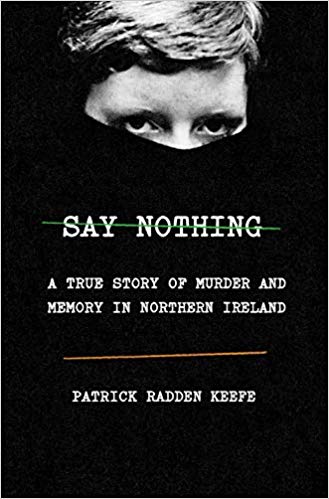Say Nothing: A True Story of Murder and Memory in Northern Ireland
- By Patrick Radden Keefe
- Doubleday
- 464 pp.
- Reviewed by Tom Glenn
- February 27, 2019
A gruesome tale, graphically told.

“The Troubles” is the term used to describe the bloody conflict in Northern Ireland starting in the late 1960s and ending, officially at least, in 1998, when the warring parties agreed to a cease-fire. Say Nothing relates the story by focusing on just one of the victims, Jean McConville, a 38-year-old widowed mother of 14 (with 10 still living at the time) who was “disappeared” in Belfast in 1972.
The title of the book comes from a poem by Seamus Heaney about the Troubles:
O land of the password, handgrip, wink and nod,
Whatever You Say, Say Nothing.
The story of the Troubles is complex, filled with unknowns because of the secrecy of both the Irish nationalists, also called republicans, and their foes, referred to as unionists or loyalists, aided and abetted by the British government. The nationalists were mostly Catholic, the unionists principally Protestant.
The nationalist Irish Republican Army (IRA) and its political counterpart, Sinn Féin, fought to consolidate with the Republic of Ireland to its south and thereby form a united Ireland. Their adversaries struggled to assure that Northern Ireland would continue as a part of the British empire. The nationalist strategy relied on terrorism — including the murder of those who sided with the British against them — and clandestine sabotage. The unionists used similar practices.
Early in the conflict, the IRA split into two factions, the Provisional IRA, known as the Provos, and the Official IRA, called the Stickies, who attacked each other. Unionist paramilitaries included the Ulster Volunteer Force (UVF) and Ulster Defence Association (UDA).
British state security forces were the British Army and the Royal Ulster Constabulary (RUC), later rebranded the Police Service of Northern Ireland (PSNI). But some of the guerrilla warfare was carried out by nationalists or unionists only marginally associated with any of these organizations.
Author Patrick Radden Keefe labels those who snitched on nationalist members and their operations as “touts.” Their punishment was murder, when their bodies were left in the streets, or “disappearance,” when they were buried in hidden graves. Before the conflict came to a nominal close with the signing of the Good Friday agreement in 1998, some 3,500 from both sides were killed, more than half of them civilians.
Say Nothing highlights the importance of the two most famous events of the Troubles. They are Bloody Sunday in January 1972, when British paratroopers opened fire on a huge mass of peaceful protesters, killing 13 and wounding 15. Bloody Sunday became a galvanizing event for the nationalists, who now turned from peaceful means to violence. Then came Bloody Friday in March 1973, when the IRA planted bombs all over Belfast and ended up killing many innocent civilians.
The Good Friday agreement stipulated that Northern Ireland would remain part of the United Kingdom but with its own assembly and close links to the Republic of Ireland. In other words, neither side won, but the human price of continuing the war dictated a cease-fire.
Keefe tells of dozens of nationalists engaged in action against the British and the loyalists, but three stand out. One is Dolours Price, who, along with her sister Marian, committed murders and planted bombs. Her veiled face is on the cover of the book. Equally famous was Brandon Hughes, responsible for many deaths.
And, finally, Gerry Adams, a leading figure in Sinn Féin and probably the IRA, though, in his later career as a politician, he denied any connection to murders or terrorist activities. All three were complicit in the guerrilla war and the atrocities undertaken to oust the British from Northern Ireland.
The sheer grisliness of the Northern Irish resistance made reading Say Nothing tough going. Ten nationalists starved themselves to death while imprisoned by the British. Some 16 “touts” were “disappeared,” including several whose graves were never found. Nearly 300 police officers were killed. Torture on both sides was common. Fear became a way of life.
During the early years of the Troubles, I was in Vietnam. Later, I was operating undercover elsewhere. I was so focused on my own survival that I paid little attention to the ghastly happenings in Northern Ireland. So much of Keefe’s story was new to me.
Even as one who has experienced gruesome events on the battlefield, I often had to put Say Nothing aside as I recovered from the shock of the events depicted. Keefe is blatant in his narration. He should have been. The story of the Troubles is grim history best told graphically.
Every year between 1962 And 1975, Tom Glenn, who speaks Vietnamese, Chinese, and French, spent at least four months in Vietnam as a clandestine signals intelligence operative before escaping under fire when Saigon fell. He has 17 short stories and four novels in print, with another novel due out next year. Most of his fiction is about Vietnam.
_80_124.png)
